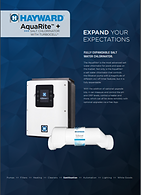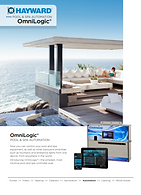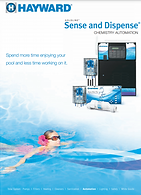
POOL CARE TIPS
The last step in commissioning your pool is getting it ready for swimming - and showing you how to keep it crystal clear with minimal effort.
Congratulations! It's time to jump in.
Before handover, we will ensure that your pool water chemistry is balanced for safe and comfortable swimming.
You'll observe that this involves emptying numerous bags of pool salt into the water. What does all that salt do? Through a process called electrolysis, the salt chlorinator attached to your pool uses dissolved salt to produce chlorine. These chlorine compounds keep your pool clean and clear of nasties, such as bacteria and algae.
It's normal for your pool water to be a little cloudy for the first 24 hours. This will clear as the salt dissolves.
Chemical testing
We will chemically balance your pool water and show you how to use the testing kit we supply.
The kit is easy to use and comes with clear instructions. Or you may prefer to have your water tested by a pool supply shop. You simply collect a jar of pool water and take it to them for analysis. We would be pleased to recommend a pool store in your area.

Water testing made easy
You don't need a science degree to keep your pool balanced and looking fantastic, but it can help to understand a few basics about pool chemistry. In this section, we are going to explain four of the key indicators of pool health: pH, total alkalinity, chlorine and salt.
Potential of Hydrogen (pH)
pH is a measure of how acidic or alkaline the water is. A pH reading of 7.0 is neutral, while anything below 7.0 is acidic, and anything over 7.0 is alkaline.
The ideal pH for your pool water is between 7.2 and 7.6.
A pH above 7.6 is not desirable because it reduces the effect of chlorine and can lead to cloudy water, scaling and water marking. At pH levels below 7.2, the water becomes increasingly corrosive to surfaces and surrounds, and may be irritating to swimmers.
When you test your pool water in the weeks following handover, you will likely observe that the pH ranges too high (over 7.6). This is normal and expected because the pool interior is releasing alkaline compounds from aggregate and grout.
To chemically balance your newly commissioned pool, you will need to reduce the pH by adding acid to the water. The Acid Demand Test will specify how much acid needs to be added.
Please take care when handling acid. For your safety, wear gloves and eye protection and store chemicals out of reach of children.
What if your pH reading is too low?
A pH level below 7.2 is less likely, especially when your pool is new. However, organic factors such as rainwater, leaves, grass, body sweat, sunscreen, and urine can all contribute to a low pH reading. This is why it's important to check your pool's chemical balance after a big event, including heavy rain and pool parties.
To increase pH to the ideal level, you would add sodium carbonate according to the amount recommended for your pool volume and pH reading.
When adding chemicals to your pool, set the filtration pump speed to maximum for at least 15 minutes to ensures strong water circulation.
Total Alkalinity (TA)
Total Alkalinity (TA) is a measure of bi-carbonates, carbonates and hydroxides in your water.
The ideal TA range is 80-120 parts per million (ppm).
At the right level, these compounds help to keep pH stable. Low TA will contribute to corrosion, while high TA will make the water cloudy and reduce the sanitising effect of chlorine.
To reduce TA, add hydrochloric acid to the water. To increase TA, add sodium bicarbonate according to the amount recommended by a pool shop or your test kit.
Avoid big swings in your pool chemistry by adding small amounts of chemicals and re-testing the water after 15 minutes.
Chlorine
Chlorine works as a sanitising agent in your pool water. When chlorine levels are too low, your pool may become vulnerable to microbe and algae outbreaks. When too high, chlorine may damage equipment, seals and surfaces, and cause irritation to swimmers.
Back in the day, pool owners had to add chlorine to their pool water. However, modern pools are fitted with a system that produces chlorine compounds from salt. As long as you keep chlorine levels in the ideal range, you will never need to add chlorine chemical granules to your water.
Controlling chlorine levels
To control chlorine levels, you adjust the output of your salt chlorination system.
Keep in mind that chlorine levels are affected by seasonal conditions and pool use. During summer, when your pool is being used daily and the sun is at its strongest, you may need to increase the output of the chlorinator to maintain ideal chlorine levels.

Salt
With a new Hayward salt chlorination system, the ideal salt level is 3000 parts per million. If you have the older Hayward PS series salt chlorinator, the ideal salt level in your pool is 3750 ppm. With either system, you do not need to test for salt level.
The chlorinator system will alert you with a warning light should salt levels become low.
Simply take a water sample to your local pool supply shop and they will calculate how much salt is required to correct the level.
Your pool is likely to need more salt periodically, especially after heavy rain.
Salt Chlorinators
We will recommend the right system for your pool, needs and budget.
Read more about salt chlorination systems by clicking on the brochures below:
Hayward AquaRite
Standard Salt Chlorinator System
Upgrade options are a top seller!
Hayward OmniLogic
Pool & Spa Automation
Not all options sold in Australia
Hayward Aqua Plus
All-in-one Automation & Chlorination
Last page of brochure
Pool Care Checklist
Skim off dead leaves and debri - Use a long-handled leaf skimmer to gather up leaves, insects and any other debris floating on the surface. Removing debris before it sinks is a good way to avoid staining.
Vacuum - Set your pool cleaning robot to work or submerge your vacuum head and hose before hooking it up to the filter. (Those with an automated in-floor cleaning system can relax while the pool cleans itself!)
Clean the skimmer box - Empty the filter basket in your skimmer box. This will keep it operating at maximum efficiency.
Test and adjust water - Test your water, add chemicals and adjust chlorinator, as needed.
Backwash filter - Once a month, backwash your filter for three minutes (or until the water in the sight glass is clear) to keep it operating at maximum efficiency. Follow the backwash with the rinse setting for about 30 seconds or until the water in the sight glass is clear.
Top up water level (as needed) - Top up your pool whenever the water level falls to about three-quarters down the skimmer box entry. (Does not apply to pools with automatic water leveling.)
Gold Coast Pool Tips
South East Queensland homeowners would be familiar with some of these local and unique pool care situations.
Heavy rain - When you clean your pool filter by backwashing, water is pumped out of the pool into the drain, therefore heavy rain is a good time to backwash. As well as flushing the filter, you can reduce your pool's water level to prevent overflowing.
Rain shortage - Your pool level is likely to drop significantly during extended periods of no rain. A pool cover can be an excellent investment. As well as reducing water loss to evaporation, it prevents leaves and debris from entering the pool.
Bat droppings - Bat droppings, or guano, can be one of the most stubborn stains to remove from your pool. Because it's sticky, dense, and prone to sinking without dispersing, guano requires targeted treatment. If the stain is in a shallow area (such as steps or a ledge), carefully pour a small amount of acid directly onto the stain with the pool pump turned off. Since acid is heavier than water, it will sink and settle onto the affected area in still water. For deeper sections of the pool, try placing a small amount of chlorine granules and gravel (to weigh it down) into a stocking or porous cloth. Tie it off securely and position it directly over the stain. Leave it in place for 24–48 hours for best results.



